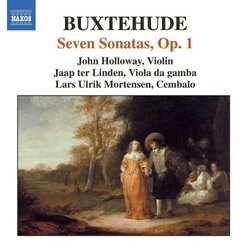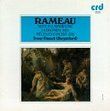| All Artists: Dietrich Buxtehude, John Holloway, Jaap ter Linden, Lars Ulrik Mortensen Title: Buxtehude: 7 Sonatas, Op 1 Members Wishing: 0 Total Copies: 0 Label: Naxos Release Date: 4/19/2005 Genre: Classical Styles: Chamber Music, Historical Periods, Baroque (c.1600-1750), Classical (c.1770-1830) Number of Discs: 1 SwapaCD Credits: 1 UPC: 747313224821 |
Search - Dietrich Buxtehude, John Holloway, Jaap ter Linden :: Buxtehude: 7 Sonatas, Op 1
 | Dietrich Buxtehude, John Holloway, Jaap ter Linden Buxtehude: 7 Sonatas, Op 1 Genre: Classical
|
Larger Image |
CD DetailsSimilar CDs
|
CD ReviewsAward-Winning Performances, and Deservedly So J Scott Morrison | Middlebury VT, USA | 05/07/2005 (5 out of 5 stars) "Although Dieterich Buxtehude (c. 1637-1707) spent most of his life in Lübeck, Germany, the Danes have always been proud to claim him as one of their own because he spent his formative years in Denmark. The Danish record label, da capo, originally published these performances of his Sonatas, Op. 1, for violin, viola da gamba and harpsichord, in 1995 and it won a Danish 'Grammy' that year. And no wonder. These are marvelous performances by three marvelous musicians -- John Holloway, violin, Jaap ter Linden, viola da gamba, and Lars Ulrik Mortensen, harpsichord. Holloway has recorded much baroque music, including a terrific set of Biber sonatas. For a time ter Linden seemed to appear on every baroque recording that came my way. Mortensen participated in one of my favorite recordings of this past year, a set that contained performances of Bach harpsichord concerti. Holloway, long the concertmaster of Roger Norringston's London Classical Players, has just been named music director of Atlanta's hot baroque ensemble, New Trinity Baroque. Buxtehude is remembered mostly as a composer of organ and sacred music. He was organist at the main church in Lübeck for almost forty years. The story of how Bach walked to Lübeck to study with Buxtehude is well-known. He wrote very little chamber music, and this disc is one of a series of three that contains the lot. One presumes that Naxos will reissue Vols. 2 & 3 in due time. Op. 1 consists of seven 'sonatas,' which are composed partially in his 'stylus phantasticus' in which each of the instrumentalists, rather as in jazz, is allowed free improvisation for a few measures in turn. Actually, of course, Buxtehude composed those measures, but the effect is one of spontaneous improvisation for each of the players. As Kerala Snyder has it in the New Grove's, "These are sonatas a due, based on virtuoso and integrated writing for the violin and gamba. Although real trio texture sometimes occurs, the continuo line is more often a simplification of the gamba part. The structure of the sonatas is based on an alternation of tempo and texture, but this can take place either by means of tonally closed, independent movements or with sections that flow together; there is no standardization of their number, which ranges from three to 14." Half the sonatas have an ostinato movement in which a pattern is set up in the continuo and followed through to the end. To this listener, the sonatas overall convey a sense of informality, brio, and an almost romantic expression of feeling. It is entirely apt that this CD's instrumentalists mirror that approach in their playing. The result is joyous. One comes away from this music refreshed, invigorated, stimulated. One looks forward the next release, the Op. 2 set, also of seven sonatas. TT=57:40 Warmly recommended. Scott Morrison" Provides a context for J.S. Bach Jamesian | Connecticut USA | 12/26/2006 (5 out of 5 stars) "This is wonderful stuff. You can listen to it with pleasure without concerning yourself with history or musicology at all.
But if you ARE interested in such matters, Buxtehude was not only n influence upon, he was an inspiration to, the incomparable J.S. Bach. It takes nothing away from Bach to say that his genius didn't come from nowhere, it didn't drop onto this planet from Mars. And when you listen with that thought in mind, you get extra levels of satisfaction from this recording." |

 Track Listings (24) - Disc #1
Track Listings (24) - Disc #1
